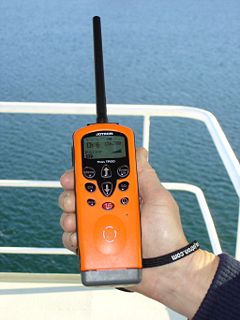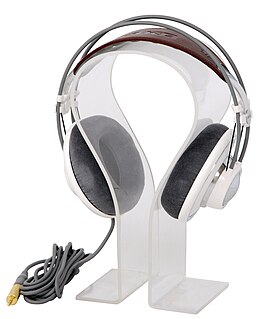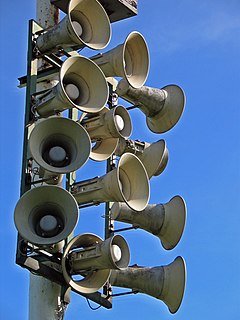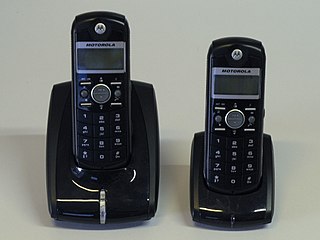Sidetone is audible feedback to someone speaking or otherwise producing sound as an indication of active transmission. Sidetone is introduced by some communications circuits and anti-sidetone circuitry is used to control its level.
Sidetone is expected behavior for telephone systems. Absence of sidetone can cause users to believe the call has been dropped or cause them to speak loudly. Too much sidetone can cause users to speak softly.
In telephony, sidetone is the effect of sound picked up by the telephone's transmitter (mouthpiece) and instantly introduced at a low electronic signal level into the receiver (earpiece) of the same handset, a form of electrical feedback through the telephone hybrid. Sidetone in early 19th century telephones was strong due to the type of circuit used in instruments. Anti-sidetone circuitry in the telephone hybrid brought sidetone under control in the early 20th century, leaving enough feedback signal to assure the user that the telephone is working.
Almost all land-line (wired and wireless) telephones have employed sidetone, so it was an expected convention for cellular telephony, but is not standard. The amount of sidetone on land-lines is typically 8%, and is 4% for cellular phones.[ citation needed ] Usability experts believe that lack of adequate sidetone causes some people to shout or speak too loudly when using a cell phone, a behavior that is sometimes referred to as "cell yell". [1] [2]
One of the benefits of sidetone-enabled phones is that a user knows a call has been dropped or ended if he or she no longer hears sidetone. Comfort noise provides a similar benefit.
Sidetone is disabled when telephones are running in speakerphone mode to prevent direct acoustical feedback from the speaker to the microphone, resulting in howling. Sidetone can be, and often is, amplified for land-line phones for the hearing impaired.
In wireless telegraphy (WT) and amateur radio, sidetone is the audible indication of a continuous wave (CW) signal as the operator sends Morse Code. As in telephony, sidetone serves as feedback to the operator that what they are sending is what is intended.
It is designed to mimic the tone generated by a typical radio receiver when a CW signal is converted to the intermediate frequency (IF), then mixed with the Beat frequency oscillator (BFO) frequency to generate a difference frequency, which is audible over the radio receiver loudspeaker or headphones.
Sidetone is also used on voice radio equipment to give the radio operator confidence that they are transmitting over the radio. The sidetone audio is typically derived from the transmit audio circuitry.
When a commentator, announcer, or MC for a public event may otherwise be able to hear their own voice in the delayed output from the loudspeakers, they may opt to use a headset which provides instant sidetone of their own voice, thus removing the distracting effect of greatly delayed auditory feedback from the loudspeakers.

Code-division multiple access (CDMA) is a channel access method used by various radio communication technologies. CDMA is an example of multiple access, where several transmitters can send information simultaneously over a single communication channel. This allows several users to share a band of frequencies. To permit this without undue interference between the users, CDMA employs spread spectrum technology and a special coding scheme.

A telephone is a telecommunications device that permits two or more users to conduct a conversation when they are too far apart to be heard directly. A telephone converts sound, typically and most efficiently the human voice, into electronic signals that are transmitted via cables and other communication channels to another telephone which reproduces the sound to the receiving user. The term is derived from Greek: τῆλε and φωνή, together meaning distant voice. A common short form of the term is phone, which came into use almost immediately after the first patent was issued.

Wireless telegraphy or radiotelegraphy is transmission of telegraph signals by radio waves. Before about 1910, the term wireless telegraphy was also used for other experimental technologies for transmitting telegraph signals without wires. In radiotelegraphy, information is transmitted by pulses of radio waves of two different lengths called "dots" and "dashes", which spell out text messages, usually in Morse code. In a manual system, the sending operator taps on a switch called a telegraph key which turns the transmitter on and off, producing the pulses of radio waves. At the receiver the pulses are audible in the receiver's speaker as beeps, which are translated back to text by an operator who knows Morse code.

In telecommunications, a repeater is an electronic device that receives a signal and retransmits it. Repeaters are used to extend transmissions so that the signal can cover longer distances or be received on the other side of an obstruction. Some types of repeaters broadcast an identical signal, but alter its method of transmission, for example, on another frequency or baud rate.
In radio communication, a transceiver is an electronic device which is a combination of a radio transmitter and a receiver, hence the name. It can both transmit and receive radio waves using an antenna, for communication purposes. These two related functions are often combined in a single device to reduce manufacturing costs. The term is also used for other devices which can both transmit and receive through a communications channel, such as optical transceivers which transmit and receive light in optical fiber systems, and bus transceivers which transmit and receive digital data in computer data buses.

In electronics and telecommunications, a radio transmitter or just transmitter is an electronic device which produces radio waves with an antenna. The transmitter itself generates a radio frequency alternating current, which is applied to the antenna. When excited by this alternating current, the antenna radiates radio waves.

Wireless communication is the transfer of information between two or more points without the use of an electrical conductor, optical fiber or other continuous guided medium for the transfer. The most common wireless technologies use radio waves. With radio waves, intended distances can be short, such as a few meters for Bluetooth or as far as millions of kilometers for deep-space radio communications. It encompasses various types of fixed, mobile, and portable applications, including two-way radios, cellular telephones, personal digital assistants (PDAs), and wireless networking. Other examples of applications of radio wireless technology include GPS units, garage door openers, wireless computer mouse, keyboards and headsets, headphones, radio receivers, satellite television, broadcast television and cordless telephones. Somewhat less common methods of achieving wireless communications involve other electromagnetic phenomena, such as light and magnetic or electric fields, or the use of sound.

Headphones are a pair of small loudspeaker drivers worn on or around the head over a user's ears. They are electroacoustic transducers, which convert an electrical signal to a corresponding sound. Headphones let a single user listen to an audio source privately, in contrast to a loudspeaker, which emits sound into the open air for anyone nearby to hear. Headphones are also known as earspeakers, earphones or, colloquially, cans. Circumaural and supra-aural headphones use a band over the top of the head to hold the speakers in place. Another type, known as earbuds or earpieces consist of individual units that plug into the user's ear canal. A third type are bone conduction headphones, which typically wrap around the back of the head and rest in front of the ear canal, leaving the ear canal open. In the context of telecommunication, a headset is a combination of headphone and microphone.

A pager is a wireless telecommunications device that receives and displays alphanumeric or voice messages. One-way pagers can only receive messages, while response pagers and two-way pagers can also acknowledge, reply to and originate messages using an internal transmitter.

In radio communications, a radio receiver, also known as a receiver, a wireless, or simply a radio, is an electronic device that receives radio waves and converts the information carried by them to a usable form. It is used with an antenna. The antenna intercepts radio waves and converts them to tiny alternating currents which are applied to the receiver, and the receiver extracts the desired information. The receiver uses electronic filters to separate the desired radio frequency signal from all the other signals picked up by the antenna, an electronic amplifier to increase the power of the signal for further processing, and finally recovers the desired information through demodulation.

A public address system is an electronic system comprising microphones, amplifiers, loudspeakers, and related equipment. It increases the apparent volume (loudness) of a human voice, musical instrument, or other acoustic sound source or recorded sound or music. PA systems are used in any public venue that requires that an announcer, performer, etc. be sufficiently audible at a distance or over a large area. Typical applications include sports stadiums, public transportation vehicles and facilities, and live or recorded music venues and events. A PA system may include multiple microphones or other sound sources, a mixing console to combine and modify multiple sources, and multiple amplifiers and loudspeakers for louder volume or wider distribution.

A hearing aid is a device designed to improve hearing by making sound audible to a person with hearing loss. Hearing aids are classified as medical devices in most countries, and regulated by the respective regulations. Small audio amplifiers such as PSAPs or other plain sound reinforcing systems cannot be sold as "hearing aids".

A cellular network or mobile network is a communication network where the link to and from end nodes is wireless. The network is distributed over land areas called "cells", each served by at least one fixed-location transceiver. These base stations provide the cell with the network coverage which can be used for transmission of voice, data, and other types of content. A cell typically uses a different set of frequencies from neighboring cells, to avoid interference and provide guaranteed service quality within each cell.

A cordless telephone or portable telephone is a telephone which has a portable handset but which one can use like landline phone communication; such telephones operate using radio-frequency transmission rather than a physical insulated wire or a direct connection to a telephone line. A cordless telephone's base station connects with the telephone network through a telephone line and also includes a charger to charge the handset's batteries. The operational range is limited, usually to the same building or within some short distance from the base station.

An intercom, also called an intercommunication device, intercommunicator, or interphone, is a stand-alone voice communications system for use within a building or small collection of buildings which functions independently of the public telephone network. Intercoms are generally mounted permanently in buildings and vehicles. Intercoms can incorporate connections to public address loudspeaker systems, walkie talkies, telephones, and other intercom systems. Some intercom systems incorporate control of devices such as signal lights and door latches.
A duplex communication system is a point-to-point system composed of two or more connected parties or devices that can communicate with one another in both directions. Duplex systems are employed in many communications networks, either to allow for simultaneous communication in both directions between two connected parties or to provide a reverse path for the monitoring and remote adjustment of equipment in the field. There are two types of duplex communication systems: full-duplex (FDX) and half-duplex (HDX).
The Mobile Telephone Service (MTS) was a pre-cellular VHF radio system that linked to the Public Switched Telephone Network (PSTN). MTS was the radiotelephone equivalent of land dial phone service.

This history of the telephone chronicles the development of the electrical telephone, and includes a brief overview of its predecessors. The first telephone patent was granted to Alexander Graham Bell in 1876.

Radio is the technology of signaling and communicating using radio waves. Radio waves are electromagnetic waves of frequency between 30 hertz (Hz) and 300 gigahertz (GHz). They are generated by an electronic device called a transmitter connected to an antenna which radiates the waves, and received by another antenna connected to a radio receiver. Radio is very widely used in modern technology, in radio communication, radar, radio navigation, remote control, remote sensing, and other applications.
Airplane mode is a setting available on smartphones and other portable devices. When activated, this mode suspends the device's radio-frequency (RF) signal transmission technologies, effectively disabling all analog voice, and digital data services, when implemented correctly by the electronic device software author. When cellular phones became prevalent in the 1990s, some communication headsets of aircraft pilots would register an audible click when a cellular phone on the aircraft would transceive a signal. This clicking on the headsets became overwhelmingly distracting to airframe control, with more and more phone calls from airplane passengers as time went on. This led to the banning of electronic device use on airplanes and ushered in the era of airplane mode. This airplane travel condition diverged cellular network device development from hardware to software and the smart phone was created.